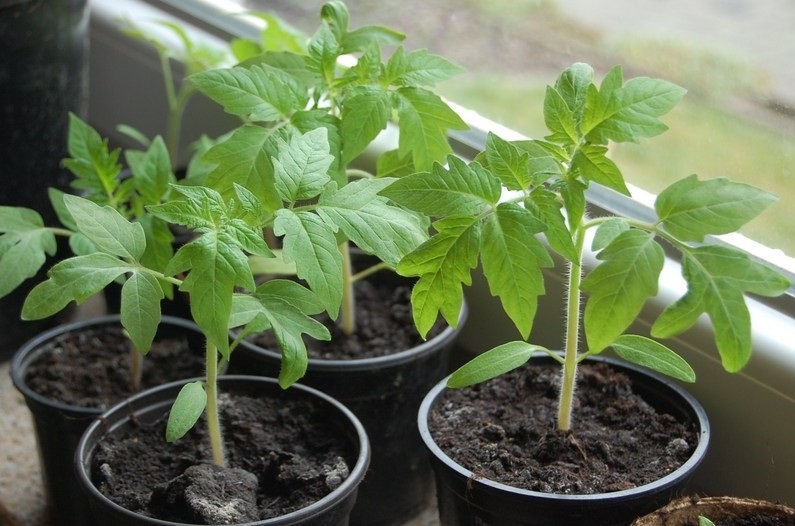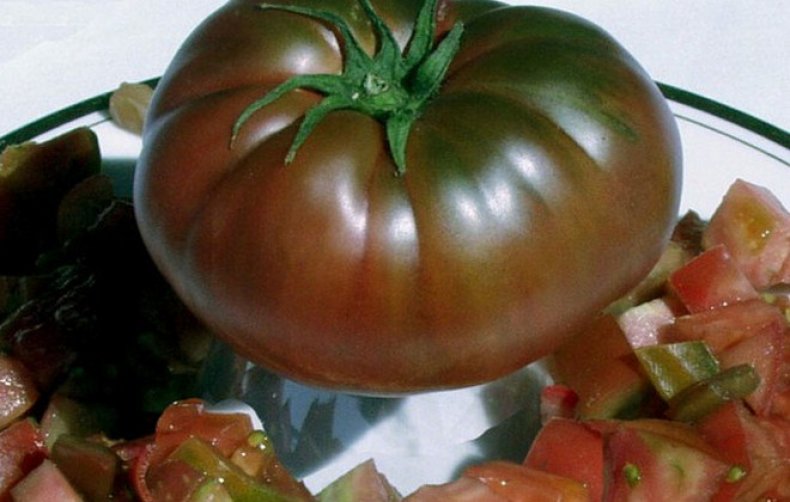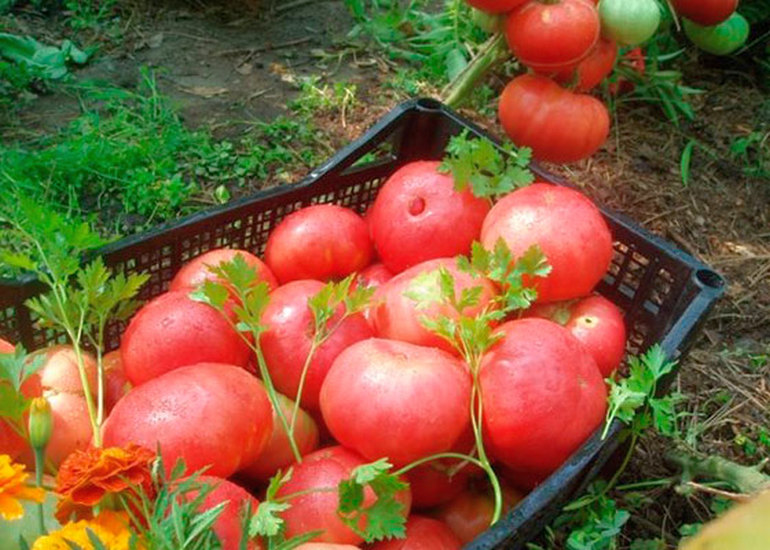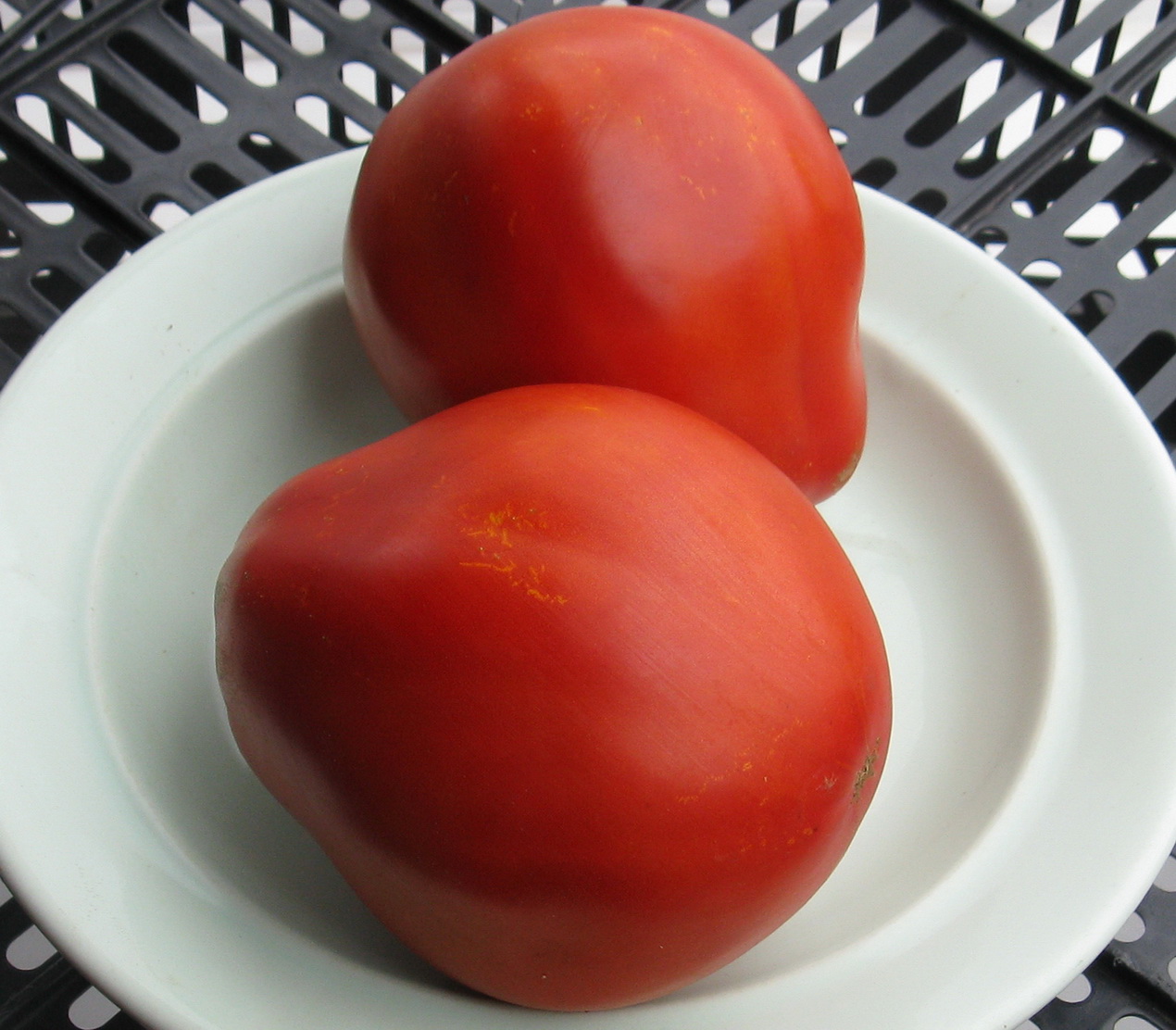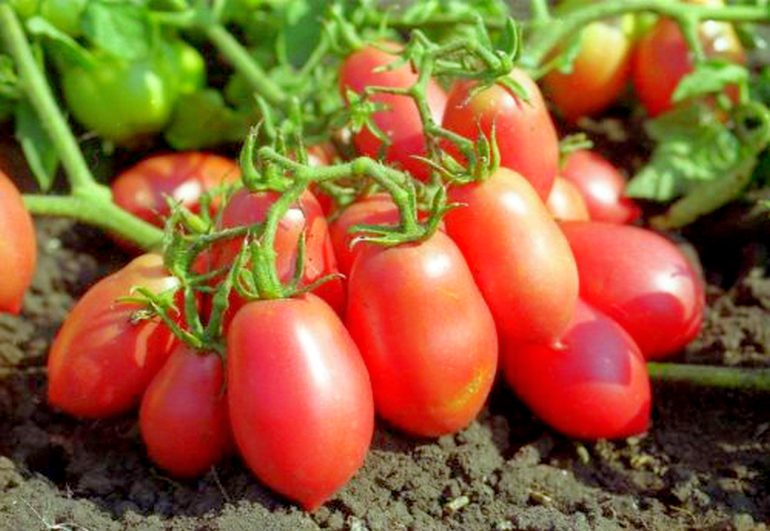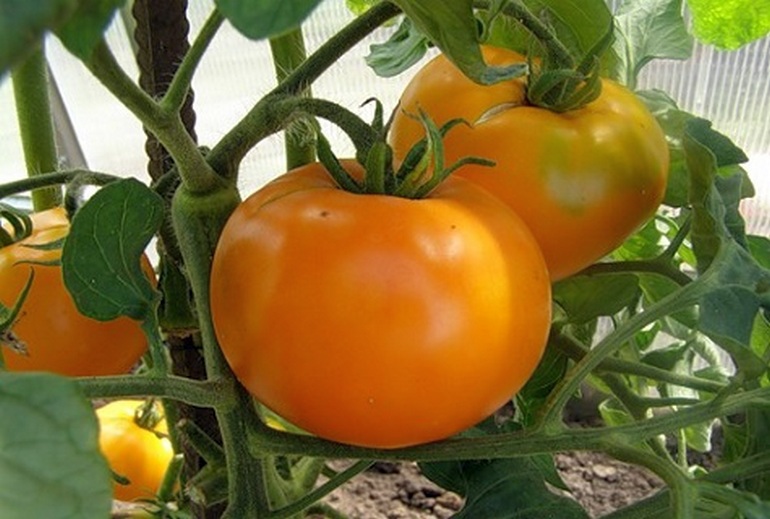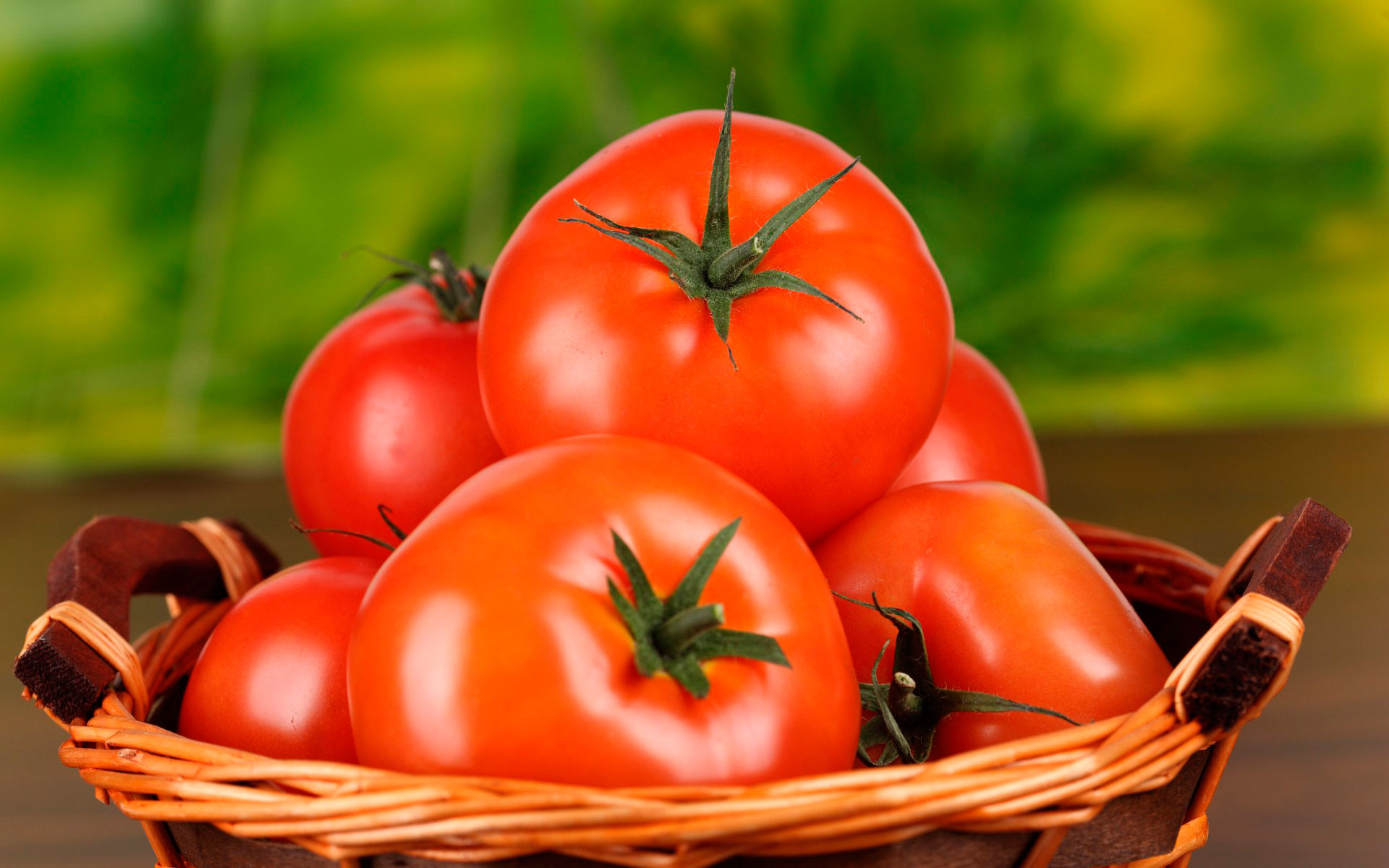Content:
The Mikado tomato is such a well-known variety that it does not need any advertising. The history of its origin is controversial among agricultural technicians. Some argue that it was bred in America 200 years ago, but in Russia Mikado was registered at the end of the last century on Sakhalin. Since then, he has won a worthy place in the agricultural market.
Characteristics of the variety
The early ripe tomato Mikado is one of the excellent varieties, without which it is impossible to prepare a dish that requires a real tomato flavor.
Mikado's pink tomato description differs from other tomato crops:
- tomato thickets look like potato beds;
- leaves are small, dense, dark green in color, resembling potato leaves;
- the height of the bush reaches 2 m;
- indeterminate plant;
- a tomato is poured up to 500 g;
- the fruit is round, flattened, ribbed;
- inside the tomato there is a chamber with 7 grain nests;
- color from light pink to dark pink and scarlet;
- the skin is smooth, very dense, which contributes to the long-term storage of the tomato;
- the taste is rich, with notes of sweetness.
Pink Mikado tomatoes with characteristics and description of the variety resemble the famous Bovine Heart variety, but they have differences.
In Mikado, the beauty of tomatoes cannot be conveyed by description - they must be seen. As a result of selection developments, fruits of different colors have been obtained. Not a single variety is endowed with such a variety of colored fruits, the nature of their cultivation is almost the same.
Mikado red
Tomato Mikado is red - the bush reaches a height of 2.5 m, requires pinching and pinching. Green leaves sit sparsely on a thick stem. The variety is not early, the fruits ripen three months after planting in open ground. Fruits are bright burgundy in color, round, with folds, ribbed, weighing more than 300 g. The taste is sugary, rich aroma, recommended for salads and making tomato juice. Suitable for canning.
The variety is grown in greenhouses and outdoors. Choose a place for planting in the open field should be away from the shade, the culture needs a lot of light. Resistant to many infections, tolerates changes in weather well. A slight decrease in temperature does not affect the yield.
Mikado golden
Mikado golden - indeterminate plant, tall, the stem needs to restrict growth. Heat-loving culture, intended for cultivation in greenhouse conditions. The brush is formed over 7 leaves, then every 3-4 leaves. Only 3 fruits are formed on the hand - one large and two smaller ones.
The fruits are large, round, grooved, slightly flattened. The bright yellow color of the tomato resembles the overflow of gold, weighing up to 500 g, inside the fruit there are 8 chambers filled with seeds. Contains a balanced amount of sugars, therefore it is recommended for baby and diet food.
The variety has a weak resistance to disease, so it is necessary to regularly carry out preventive treatments against fungal and other infections.
Mikado black
Black Mikado is the most unconventional tomato variety that attracts vegetable growers with its unusual appearance and taste.
In an indeterminate, standard plant, the stem grows 1.5 in height, which must be tied up. There are many emerald leaves on the stem, they are thinned out, and the lower few leaves are completely removed. The tomato bush must be pinched and pinched.
The mid-season variety is grown in greenhouse conditions and in the open field. Needs sunlight and abundant watering. Not resistant to white spot, requires regular preventive treatment with drugs against diseases.
The fruits are brown in color, very tasty due to the high sugar content. There are seed chambers in each tomato. On each cluster 4 fruits are formed, weighing 350-400 g. In total, 8-10 kg of first-class tomatoes can be obtained from one bush.
Distinctive features of the plant
After planting, the first ripe tomato should be expected in three months. The fruits contain a large amount of selenium and carotene, which explains their unique taste. The fleshy fruits are so large that the stem may not stand it, so the bush requires tying up at the very beginning of planting. The tomato has a powerful stem, light green in color, but it needs pinching and pinching of growth points.
Yield
The largest tomato Mikado was grown in America, its weight reached 3 kg. An average formed bush can produce up to 10 kg of delicious salad tomatoes. In order to have a good yield, it is necessary to observe the temperature regime for growing tomatoes. The plant is thermophilic, feels comfortable at a temperature of 25 degrees Celsius. With a decrease in temperature, growth stops and inhibition of ovary formation begins.
Good crop development and bountiful harvests are celebrated in greenhouse conditions or when planted in the southern regions of the country.
Agrotechnics
As a thermophilic variety, Mikado loves space, access to light and warmth. Therefore, you can not plant seedlings at close range, so that the bushes do not shade each other. There should be a distance of half a meter between the seedlings.
Seedling
The seeds are taken from the largest ripe tomato. They are carefully removed from the nests, washed, dried, stored in a dry place until the seedlings are planted. Seeds are planted in containers with fertilized soil at the end of winter. Drainage in the form of small stones, pebbles, sand is poured into the bottom of the container. The seedling soil should have a crumbly structure.
Before planting, soak the seeds in a manganese solution for 3 hours, rinse under running water. Seeds are planted every 2-3 cm, sprinkled with earth, lightly watered and covered with plastic wrap. Sometimes open the foil for ventilation.
For good growth of seedlings, it is necessary to provide good lighting. During the day, keep the containers on the windowsill, arrange artificial light at night. Seedlings need lighting for at least 15 hours a day. Fertilize the soil with mullein infusion, aloe solution.
Water the soil sparingly, it should be slightly moist, not dry. As soon as the first two leaves hatch, the seedlings dive, after two weeks the dive is repeated. The seedlings are sprayed twice with a solution of potassium permanganate or boric acid.
Landing in open ground
Hardening of seedlings is not required, since this is a greenhouse culture; it is almost never grown outdoors.
The Mikado tomato variety is planted in a greenhouse at the end of April. Before planting, fertilize the soil with mineral fertilizers, humus, mullein. Wells are made in the soil, no closer than 60 cm from each other, watered with organic fertilizers diluted with water. A seedling is planted in each hole, the earth is tamped, the lower leaves are cut off.
Care
Processing Mikado tomatoes is easy. The main thing is to ensure constant soil moisture and air temperature not lower than 25-26 degrees Celsius.
In addition, you must:
- Stealing. Form the bush from two stems, cut off the rest of the stepsons in time;
- Pinch the top of the plant;
- Water abundantly, but do not allow moisture to stagnate;
- Thin leaves on the stem for better ventilation of the bush and illumination;
- Tying is obligatory - under the weight of ripe fruits, the stem may break;
- Loosen the soil to enrich the soil with oxygen, fertilize;
- In time to carry out preventive treatment of the plant against diseases.
Bordeaux liquid is used to till the soil against pests and late blight. Copper chloride is used for prophylaxis against fungal diseases.
Advantages and disadvantages
Growing Mikado, you can make sure that the variety consists of almost the same advantages. Him:
- Excellent unique taste;
- High sugar content;
- Resistant to many diseases;
- Rapid simultaneous maturation;
- Long-term storage capacity.
Disadvantages:
- The need for pinching and pinching;
- Demanding for warmth and light;
- Average, low yield;
- Yellow fruits may crack;
- Requires mandatory loosening to saturate the soil with oxygen.
Any of the Mikado varieties are the best salad varieties, without them it is impossible to feel and enjoy the relish of a real tomato. Sauces made with Mikado will be rich and delicious.




